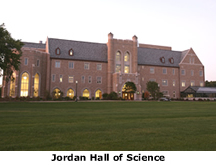
A new era in science education at Notre Dame will be officially marked Thursday (Sept. 14) with the dedication of the Jordan Hall of Science, a building that contains the most advanced scientific and educational teaching instrumentation of any university facility in the nation.
The dedication ceremonies will include a Mass in Sacred Heart Basilica at3:45 p.m., and a private blessing of the building at5:15 p.m.
The $70 million, 201,782-square-foot structure north of the Joyce Center is the largest building devoted solely to undergraduate education at the University and stands in marked contrast to facilities on other campuses across the country, where science construction and expenditures often translate solely to new laboratory space and instrumentation for researchers.
Jordan Hall will dramatically improve the way science is taught at Notre Dame by taking full advantage of the talents and ingenuity of our world-class faculty,said Joseph P. Marino, dean of the College of Science.Our students will have the opportunity to use cutting-edge technologies which will enable them to excel in their chosen fields.
Coinciding with the dedication of Jordan Hall, the second annual Notre Dame Forum, titledThe Global Health Crisis: Forging Solutions, Effecting Change,will be held Thursday in the UniversitysJoyceCenterarena. Moderated by Gwen Ifill, senior correspondent for the NewsHour with Jim Lehrer, the forums panelists include economist Jeffrey Sachs, director of the UN Millennium Project, medical anthropologist and physician Dr. Paul Farmer, founder of Partners in Health, and Dr. Miriam Laker Opwonya of Uganda, a medical doctor who specializes in tropical medicine and international health issues.
Jordans majestic Great Hall features 12 glass-enclosed display cases that house presentations on a wide variety of scientific topics.
The building includes 40 undergraduate teaching laboratories for instruction in biology, chemistry and physics and two innovative 250-seat lecture halls in which faculty can display different images simultaneously on three screens.
A 135-seat digital visualization theater enables students and the general public to move freely through a 3-D star field, viewing endless astronomical phenomena. Moreover, the same digital projection system can display large protein molecules or show students the inner working of a biological cell, all projected on the rooms domed ceiling.
The facility also features an observatory, greenhouse and herbarium.
The move into Jordan Hall unofficially began June 14 when the first of 600,000 animal specimens belonging to the Department of Biological Sciences were transferred acrossJuniper Roadfrom the Galvin Life Science Center to the new facility. Jordan HallsMuseumofBiodiversitycurrently houses 268,000 dried and pressed plant specimens, as well as 280,000 invertebrates (including 50,000 mosquitoes) and 5,000 vertebrates (chiefly reptiles, amphibians, fishes, birds and mammals).
Jordan Hall was first envisioned in 1988, when Notre Dame scientists began outlining their needs to further enhance the Universitys notable record of success in science education. A leadership gift from John W.JayJordan, a Notre Dame alumnus and member of the Universitys Board of Trustees, led to Board approval for construction of the facility in 2002, and groundbreaking ceremonies were held in October 2003.
Jordan and scores of other benefactors will be honored during the dedication ceremonies.
Jordan Hall provides Notre Dame students with state-of-the-art facilities to explore the natural worldfrom the molecular network within a cell to the cosmos,said Dennis C. Jacobs, vice president and associate provost.In this spectacular learning environment, Notre Dame faculty have the privilege to train the scientific leaders of tomorrow.
TopicID: 19062